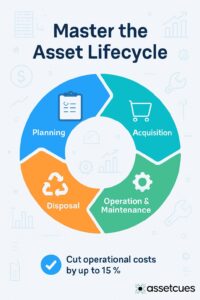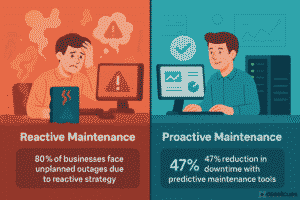Introduction
Every asset in a large organization—from servers to vehicles—goes through a life cycle. The asset lifecycle management process has four key stages: planning, acquisition, operation & maintenance, and disposal.
“Learn the full Asset lifecycle management Guide—optimize from acquisition to disposal—and discover strategies to maximize ROI.”
Each stage is crucial for maximizing asset value and performance. Effective asset lifecycle management reduces costs, improves ROI, and minimizes risks for IT and finance teams.
In fact, organizations that implement a connected asset lifecycle strategy can cut operational costs by up to 15%. A proactive approach at each stage means fewer surprises and more value from every asset.

Why should IT and finance managers care? Without a plan, managing assets is a fast track to wasted money and downtime.
By actively managing each stage, enterprises squeeze more value from their investments and avoid costly surprises. This article breaks down the asset life cycle stages and offers tips to help you optimize each phase.
What are the stages of the asset life cycle?
- Planning: determining needs and budgeting before acquiring an asset.
- Acquisition: procuring or purchasing the asset and putting it in place.
- Operation & Maintenance: using the asset effectively and upkeeping it to extend its life.
- Disposal: retiring, replacing, or disposing of the asset responsibly at end-of-life.
These asset lifecycle phases are sequential but also continuous. The disposal of one asset often leads back to planning for a replacement. Understanding this big-picture cycle helps IT and finance teams make smarter decisions at each step and align their strategies accordingly.
Stage 1: Planning
What happens in the planning stage of an asset’s lifecycle?
The planning stage lays the groundwork for an asset’s entire life. Before anything is purchased, stakeholders determine if a new asset is needed, what value it can deliver, and what it will cost.
This needs assessment ensures the asset will meet a real business requirement and support organizational goals. It also involves defining requirements and forecasting return on investment (ROI) – a critical step for finance when making the business case.
Planning also involves budgeting and risk analysis. Teams set a budget for acquiring and operating the asset, and they identify potential risks like technological obsolescence or high maintenance needs.
This phase is also about aligning the asset with the business strategy. IT leaders ensure any new system will fit into the existing tech infrastructure, and finance leaders factor in depreciation and total lifecycle cost before approving the spend.
Modern tools like digital twins (virtual asset models) can improve planning accuracy by simulating an asset’s performance before purchase. The more accurately you plan using such techniques, the better the results down the road.
By the end of the planning stage, the team should know exactly what is needed and why, and have a plan for how to justify it. This stage sets a strategic foundation that guides all subsequent asset management stages.
Learn how to maximize ROI through effective asset lifecycle planning>>
Stage 2: Acquisition (Procurement)
How to acquire assets effectively in the lifecycle?
Effective acquisition is about more than just buying the item – it’s a structured procurement process. Typically, procurement involves:
- Identifying the best-fit asset that meets the requirements defined in planning.
- Researching and shortlisting vendors or suppliers, evaluating options against criteria like quality, support, and compatibility.
- Negotiating pricing, terms, and contracts to get the best value (including warranty and service agreements).
- Finalizing the purchase and arranging delivery and deployment logistics.
Throughout acquisition, consider the total cost of ownership (TCO), not just the sticker price. A slightly more expensive asset might have lower maintenance and energy costs, making it cheaper in the long run. For example, a higher-quality server with a good support plan may cost more upfront but avoid downtime later.
Also plan how the new asset will be installed and integrated into current systems, and schedule any necessary user training. IT teams ensure compatibility with existing infrastructure and software, while finance teams verify that the purchase aligns with budgets and compliance requirements. By handling these checks upfront, the organization avoids unpleasant surprises later.
Think long-term: sometimes paying a bit more upfront for a higher-quality asset (with better support) yields greater savings over its lifetime than choosing a cheaper alternative.
Stage 3: Operation & Maintenance
How do you manage assets during the operation and maintenance phase?
Once the asset is deployed, it enters the operation and maintenance phase – the longest part of its lifecycle. From day one, IT monitors the asset’s performance (uptime, workload, output quality) while finance tracks operational costs, maintenance expenses, and depreciation. The goal is to use the asset optimally and ensure it delivers expected value.
There are two approaches to maintenance: reactive vs. proactive. Reactive (“run-to-failure”) maintenance means waiting until something breaks to fix or replace the asset, and this approach often leads to unexpected downtime and higher costs. In fact, over 80% of companies have experienced unplanned outages due to lack of proactive upkeep.

By contrast, preventive maintenance schedules regular check-ups, servicing, software updates, and part replacements before failures occur. Some organizations go further with predictive maintenance, using sensors and analytics to anticipate issues in advance. Ideally, companies adopt preventive or predictive strategies to extend the asset’s life and avoid costly emergencies.
Many organizations use technology to streamline this phase. An Enterprise Asset Management (EAM) or Computerized Maintenance Management System (CMMS) sends automated maintenance reminders, keeps service logs, and even predicts failures using AI. A cloud-based asset management platform provides a single source of truth on asset status for both IT and finance.
According to study, organizations using advanced asset management systems see 47% less unplanned downtime. These results show that proactive management in this phase pays off in reliability and cost savings.
Stage 4: Disposal (Retirement & Renewal)
What is involved in the asset disposal phase?
In the disposal phase, an asset reaches end-of-life and the organization must decide whether to retire it or replace it. The first consideration is whether the asset’s performance has declined or its maintenance costs outweigh its benefits. If so, it’s time to phase it out.
As per Investopedia studies, an asset disposal plan ensures secure disposal, cost control, and regulatory compliance during asset retirement, reducing risks and maximizing value.
For example, if a server’s outages increase and repair costs soar, replacing it might save more money. Sometimes newer technology prompts disposal even without failure, as it offers far better efficiency or performance (like upgrading to more energy-efficient equipment).
Next, consider your disposal options: an asset could be resold, redeployed, recycled, or scrapped instead of simply being thrown away. If the asset still has useful life or market value, resell it or trade it in to recoup some money, or redeploy it elsewhere in the company. If it’s no longer usable, then choose environmentally responsible recycling or disposal – especially for electronics that require proper e-waste handling and data wiping.
Importantly, disposal can also recover value. Don’t write off an asset without checking if it could be sold second-hand or used for spare parts. If it has any value, you should get paid for it rather than pay someone to haul it away. Always follow any safety and environmental rules during retirement to avoid fines or hazards.
Explore best practices in IT asset lifecycle management>>
Simplify Asset Lifecycle Management
Schedule your personalized demo to unlock efficiency at every stage.
Simplify Asset Lifecycle Management
Schedule your personalized demo to unlock efficiency at every stage.
Frequently Asked Questions
Q1: What is asset lifecycle management?
Ans: Asset lifecycle management (ALM) is the process of strategically managing an asset throughout its life. It spans from initial planning and acquisition through operation and maintenance to final disposal.
Each stage of an asset’s life optimizes cost, performance, and value. In other words, ALM manages all major asset stages from start to finish, ensuring organizations gain maximum value at every step.
Q2: Why are asset lifecycle stages important to IT and finance managers?
Ans: Each stage of the asset lifecycle gives IT and finance managers a clear framework for decision-making. For IT, defined stages (planning, acquisition, etc.) help align assets with technical needs, ensure uptime, and schedule upgrades or maintenance at the right times. For finance, these stages enable accurate budgeting, ROI tracking, and depreciation planning while helping avoid unexpected costs.
In short, clearly defined asset lifecycle phases provide predictability and efficiency for both departments. They ensure no aspect of an asset’s life is overlooked.
Q3: How do SaaS tools help with asset lifecycle management?
Ans: A modern SaaS asset management platform serves as a central hub to track assets through all lifecycle stages, providing real-time visibility, automated maintenance alerts, and analytics on usage and costs.
Conclusion & Call-to-Action
In summary, a structured asset lifecycle management process is essential for any asset-intensive organization. By actively managing each stage—from careful planning to disposal—companies avoid costly pitfalls and extract more value from their assets. The payoff is clear: lower operational costs, higher asset performance, and fewer unexpected failures, ultimately boosting the bottom line.
Now the next steps are up to you. Ready to put effective asset management into practice? Here are some ways to get started:

Optimize Your Asset Lifecycle Management with AssetCues
From automated tracking to insightful analytics, see how AssetCues helps reduce costs and improve efficiency—request a demo or contact our team today.

Optimize Your Asset Lifecycle Management with AssetCues
From automated tracking to insightful analytics, see how AssetCues helps reduce costs and improve efficiency—request a demo or contact our team today.
Still Not Sure RFID or Barcode, Which One Is Right for You?
Our experts have over a decade of experience in asset tracking and can guide you further based on your requirements
About Author






